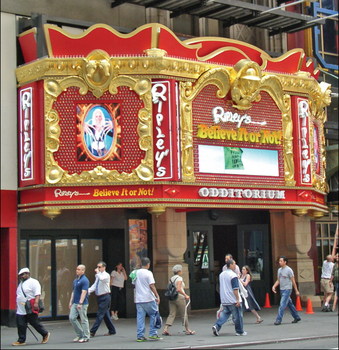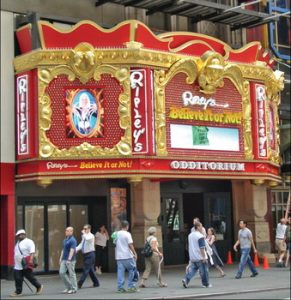With a gilded and glittering display bright enough to capture everyone’s attention, Ripley’s Believe It or Not Odditorium opened on 42nd St. (between 7th and 8th avenues). Reminiscent of an old-time circus wagon, the 16 x 35-ft., three-sided marquee houses a cornucopia of sign formats, including flashing lights, carved moldings, mechanically rotating signs, neon embellishments and LED screens, all melded into a spectacular of de-lightful viewing.
Neon outlines the exposed edges of the marquee crown, which is a decorative aluminum cornice. Directly below the crown, the marquee perimeter and sides are edged by fiberglass scroll work, created by Seal Fiberglass and rendered by Minds Eye Studios. A carving of Mr. Ripley and Ripley oddities – a two-headed calf and “Geiger” are among them – is embedded within the top molding at the center of each marquee component. As a fanciful flourish, 23k goldleaf covers all the fiberglass molding, which, according to Spectrum’s Harvey Brooks, “lends it a distinct, circus look.”
Extensive incandescent and neon lighting serves as edge and facade lighting, Brooks said. Twinkling, 11W incandescent bulbs (5,324) cover the marquee, front and each side façade. Chasing lights run back and forth across the marquee edges. Ripley’s cursive logo is mounted several times along the marquee, as open-faced, neon-lit, channel letters.
A three-sided, mechanically rotating sign component joins the corner edge of each marquee side. Each sign-face side includes an open-faced, neon-illuminated channel letter set that spells the trademark name. The Ripley’s paint scheme combines bright red with a brilliant gold satin finish and completely covers all exposed marquee surfaces.
Embedded within each marquee panel is a D3 full-color, LED video display. The main, 120 x 400-pixel, 10mm-pitch LED screen measures 45 x 120 in. The two, 60 x 45-in., 200 x 160-pixel side screens promote the enormous collection of Ripley oddities.
Advertisement
Having noted Times Square’s never-ending traffic, Spectrum pre-assembled most sign components at its Farmingdale, NY shop. Finished sign components were then placed on a wide-load trailer and brought to 42nd St., where the final sign components were fitted together above the building’s entrance.
The marquee pulls its various components into an integrated presence that acts as a carnie barker to call out to pedestrians, challenging them to “believe it or not.”
As Times Square continues evolving, the influence and importance of its evocative signage can’t be underestimated. As Times Square, and its signscape, grow in size, it becomes a compass for the rest of the sign community. Ultimately, it poses a chicken-and-egg puzzle: Does new business spawn more signage? Or does spectacular signage help businesses connect with their customers and their markets to bring more sales into their stores? It’s a little of both. Times Square’s successes are an open textbook for the sign community to learn from, and that’s always a good sign.


 Tip Sheet1 week ago
Tip Sheet1 week ago
 Photo Gallery2 days ago
Photo Gallery2 days ago
 Ask Signs of the Times4 days ago
Ask Signs of the Times4 days ago
 Real Deal1 week ago
Real Deal1 week ago
 Benchmarks6 days ago
Benchmarks6 days ago
 Editor's Note2 weeks ago
Editor's Note2 weeks ago
 Women in Signs1 week ago
Women in Signs1 week ago
 Photo Gallery1 week ago
Photo Gallery1 week ago
















